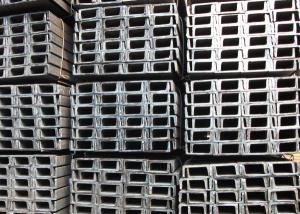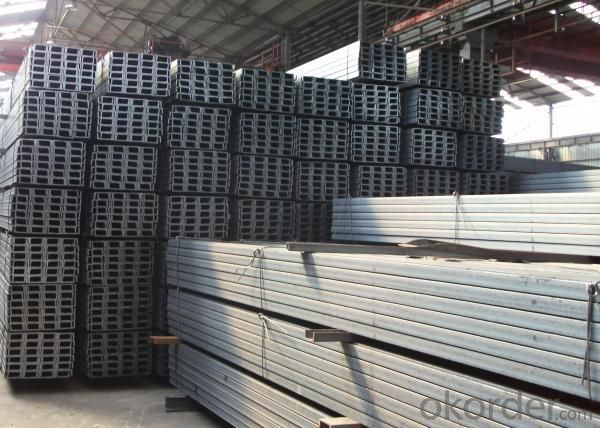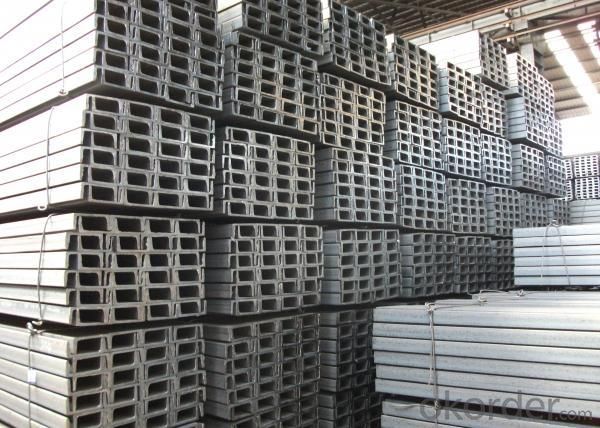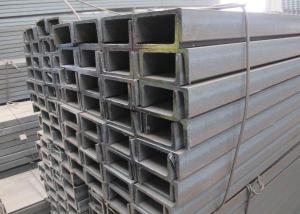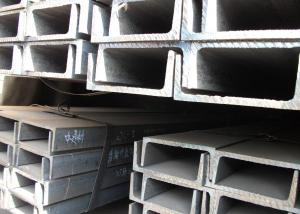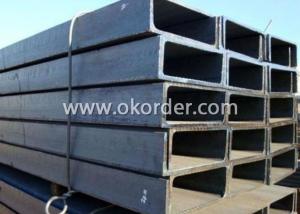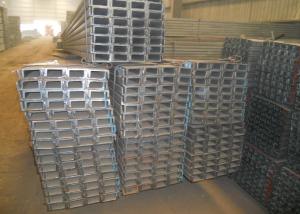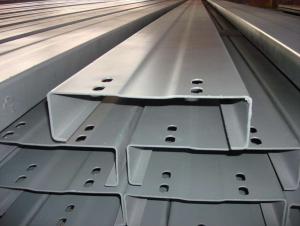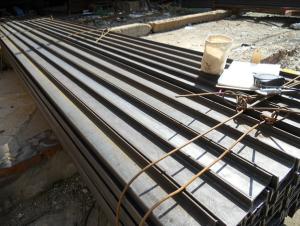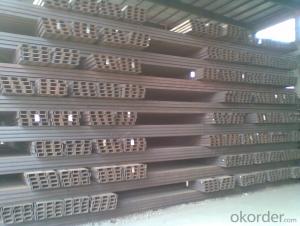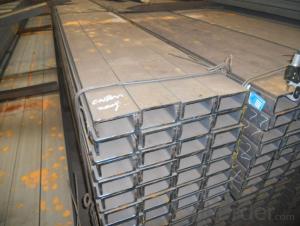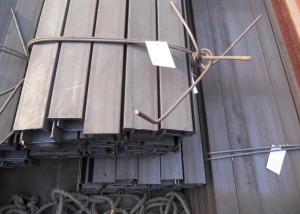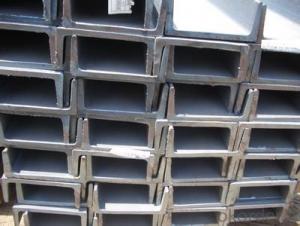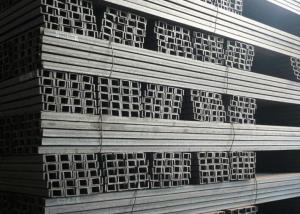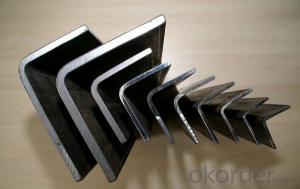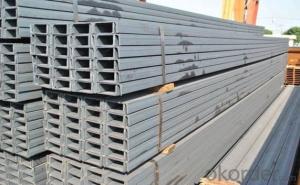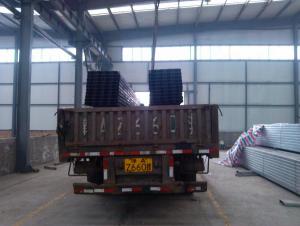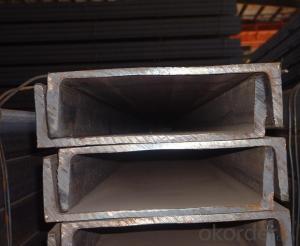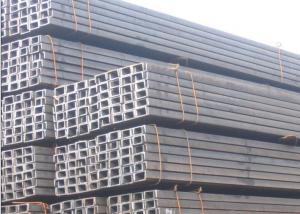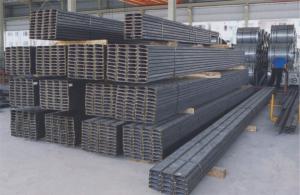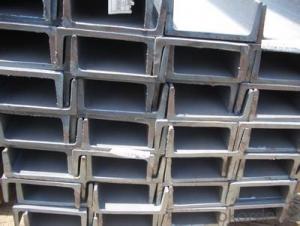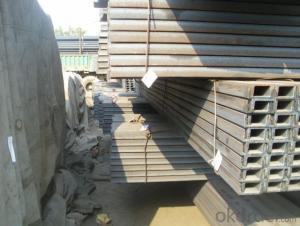JIS U CHANNEL STEEL
- Loading Port:
- Xingang Port
- Payment Terms:
- TT or LC
- Min Order Qty:
- 25MT m.t.
- Supply Capability:
- 80000TON/Year m.t./month
OKorder Service Pledge
OKorder Financial Service
You Might Also Like
Specifications of JIS U Channel Steel:
1. We are definitely speciallizing in manufacturing and supplying channel steel as per japanese standard, which is characterised with high mechanical strength and competitive prices.
Original Place | Tangshan, China | Brand Name | UINDA |
Standard | JIS G3192 : 1990 | ||
Material Grade | SS490 | ||
Sizes | 50mm to 200mm | ||
Sales Volume/Year | 3000MT | ||
Destination Area | Middle East, Africa, Southeast Asia | ||
2. The sections in details are as followings in the table-1
JIS U CHANNEL | Standard | Sectional | Dimension |
| Mass: |
| (mm) | (mm) | (mm) | (mm) |
|
50x25 | 50 | 25 | 3.0 | 6.00 | 2.37 |
75X40 | 75 | 40 | 3.8 | 7.00 | 5.30 |
75X40 | 75 | 40 | 4.0 | 7.00 | 5.60 |
75X40 | 75 | 40 | 4.5 | 7.00 | 5.85 |
75X40 | 75 | 40 | 5.0 | 7.00 | 6.92 |
|
|
|
|
|
|
100X50 | 100 | 50 | 3.8 | 6.00 | 7.30 |
100X50 | 100 | 50 | 4.2 | 6.00 | 8.03 |
100X50 | 100 | 50 | 4.5 | 7.50 | 8.97 |
100X50 | 100 | 50 | 5.0 | 7.50 | 9.36 |
|
|
|
|
|
|
125X65 | 125 | 65 | 5.2 | 6.80 | 11.66 |
125X65 | 125 | 65 | 5.3 | 6.80 | 12.17 |
125X65 | 125 | 65 | 5.5 | 8.00 | 12.91 |
125X65 | 125 | 65 | 6.0 | 8.00 | 13.40 |
|
|
|
|
|
|
150x75 | 150 | 75 | 5.5 | 7.30 | 14.66 |
150x75 | 150 | 75 | 5.7 | 10.00 | 16.71 |
150x75 | 150 | 75 | 6.0 | 10.00 | 17.90 |
150x75 | 150 | 75 | 6.5 | 10.00 | 18.60 |
150x75 | 150 | 75 | 6.5 | 10.00 | 24.00 |
|
|
|
|
|
|
200X80 | 200 | 80 | 7.5 | 11.00 | 24.60 |
Table-1
3. The mechanical property of JIS U Channel Steel in the table-2:
Grade | Yield Strength,N/mm² | Extension Strength N/mm² | |||
Thickness of Steel,mm | |||||
≦16 | >16-≦40 | >40-≦100 | >100 | ||
SS490 | ≧285 | ≧275 | ≧255 | ≧245 | 490-610 |
Table-2
4. The chemical composition of JIS U Channel Steel as per SS490 in the table-3
Grade | Element(%) | |||
C | Mn | P | S | |
SS490 | - | - | ≦0.050 | ≦0.050 |
Table-3
Usage of JIS U Channel Steel:
1.The JIS U Channel Steel can be devided into two kinds, namely common channel steel and light channel steel. The sizes of hot rolled common channel steel range from 5# to 40#. Meanwhile, the channel steel can be divided into cold forming sectional equal channel steel, cold forming sectional unequal channel steel, cold forming inner edge channel steel and outer edge channel steel.
2.The JIS u channel steel is usually used for arch-itechtural structure, and they could be welded in order to support or hang a vari-ety of facilities. They are also usually used in combination with I beam. The channel steel with sizes under 14# is usually applied to construction engineering, as purline, while the channel steel with sizes above 16# is more likely to be used in building vehicle chassis structure and mechanical structure. Furthermore, the channel steel in sizes above 30# are target at building bridge structure, as tension bar.
3.In a word, the channel steel must possess perfect welding property, riveting property and mechanical property and so on.
Package & Delivery of JIS U Channel Steel:
1.The JIS u channel steel will be packed in bundle with steel wire at each end of every bundle and color marking in order to help the customer to recognize his goods more easily at sight.
2. And the channel steel could be loaded into 20ft or 40ft container, or by bulk cargo.If the weight of each bundle reaches more than 3.5 mt, the loading by break bulk cargo should be choosed.When the weight of each bundle reaches less than 3mt, the loading by container should be choosed.
3.As for the transportaion from mill to loading port, the truck will be usually used. And the maximum quantity for each truck is 40mt.
4.All in all, we could do in accordance with customer's request.
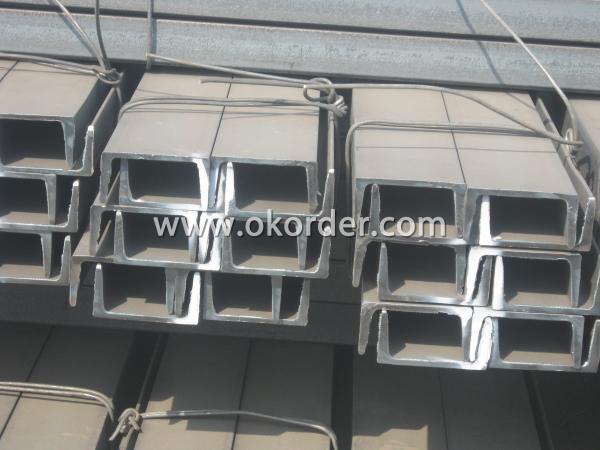
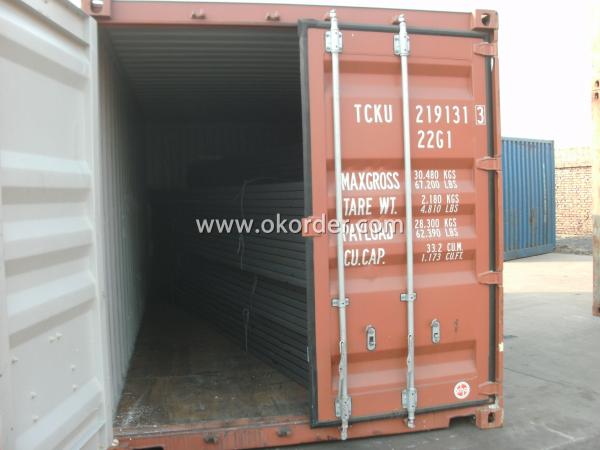
Production Flow of JIS U Channel Steel:
1.The steel billet shall be heated in the high temperature furnace.
2. The heated steel billet shall be rolled five to nine times with the aim of shaping the general figure of steel u channel.
3. The rolled steel u channel should be put onto the cooling bed to make the temperature low.
4. The steel u channel should be straighted on the straightener.
5. The straighted steel u channel will be cut into meters by saw, as per customer's requirements.
6. At the last part of production, the channel steel must be tested in order to confirm that the finished products are completely free from crack, pore, slag, scab or fold on the surface.
- Q: How are steel channels protected during transportation and storage?
- Steel channels are protected during transportation and storage through various measures to ensure their quality and prevent damage. One of the most common methods of protection is the use of protective coatings or finishes. These coatings, such as paint or galvanizing, provide a barrier between the steel channels and the external environment, preventing corrosion and rusting. During transportation, steel channels are often bundled together and secured using straps or chains to prevent movement and potential damage. They may also be placed in crates or containers to provide additional protection and prevent external forces from impacting the channels. Storage of steel channels typically involves keeping them in a dry and well-ventilated area to avoid moisture exposure. Stacking the channels on pallets or racks helps to prevent direct contact with the ground and minimize the risk of damage. Additionally, storing them in a covered area or using weatherproof covers can further protect the channels from precipitation and other weather elements. Regular inspections are crucial during transportation and storage to identify any signs of damage or deterioration. This enables prompt repairs or replacements to be carried out, ensuring that the steel channels remain in optimal condition. Overall, proper protective measures, including coatings, secure bundling, appropriate storage conditions, and regular inspections, are essential for safeguarding steel channels during transportation and storage, thereby preserving their quality and preventing potential damage.
- Q: What are the different fabrication techniques for steel channels?
- The industry commonly employs several fabrication techniques for steel channels. These techniques encompass a range of processes to shape, form, and assemble steel channels to meet specific requirements. Steel channels can be fabricated using various methods, including: 1. Hot Rolling: This technique is widely used and involves heating the steel above its recrystallization temperature. The heated steel is then passed through rollers to achieve the desired shape. Hot rolling ensures consistent dimensions and excellent mechanical properties. 2. Cold Forming: Precision is crucial in this technique, which involves shaping steel channels at room temperature or slightly above using pressure and bending techniques. Cold forming allows for tight tolerances and complex shapes and is often used in construction and manufacturing applications. 3. Welding: Steel channels can be joined by welding, a technique that employs heat and pressure to create a strong and durable bond between separate steel pieces. Welding methods include arc welding, gas welding, and laser welding. This technique is useful for creating customized steel channel configurations or repairing damaged channels. 4. Cutting and Machining: Excess material is removed to shape steel channels using cutting and machining techniques. Common methods include sawing, shearing, plasma cutting, waterjet cutting, and laser cutting. These techniques ensure precise dimensions, create openings, or eliminate unwanted sections from steel channels. 5. Forming and Bending: Forming and bending methods give steel channels specific shapes or curves. This can be achieved through processes like press braking, roll forming, or tube bending. Forming and bending enable the creation of custom-designed steel channels that fit specific applications or architectural requirements. 6. Surface Treatment: Surface treatment techniques enhance the corrosion resistance, aesthetic appearance, or functionality of steel channels. Common treatments include galvanizing, powder coating, painting, and applying protective coatings. These treatments provide an additional layer of protection and extend the lifespan of steel channels. In conclusion, fabrication techniques for steel channels include hot rolling, cold forming, welding, cutting and machining, forming and bending, and surface treatment. The choice of technique depends on specific project requirements, such as dimensional accuracy, strength, and surface finish.
- Q: What are the typical finishes available for steel channels?
- There are several typical finishes available for steel channels, depending on the desired aesthetic appeal and functional requirements. One common finish is hot-dip galvanizing, where the steel channel is dipped in a bath of molten zinc. This process provides excellent corrosion resistance, making it suitable for outdoor applications or environments where the channel may be exposed to moisture or chemicals. The zinc coating also adds a decorative appearance, with a shiny and uniform surface. Another option is powder coating, which involves applying a dry powder onto the steel channel and then curing it under heat. This finish provides a durable and attractive coating that is resistant to chipping, scratching, and fading. Powder coating can be customized in various colors, allowing for aesthetic flexibility and integration with the surrounding environment. Electroplating is another popular finish for steel channels. It involves immersing the channel in an electrolyte solution and passing an electric current through it, causing a layer of metal (such as chrome or nickel) to be deposited onto the surface. Electroplating enhances the appearance of the channel, providing a smooth and shiny finish while also offering some corrosion resistance. For a more natural and rustic look, steel channels can be left unfinished or with a bare metal finish. This option is often chosen for industrial or architectural designs where the raw and exposed metal is desired for its aesthetic appeal. In summary, the typical finishes available for steel channels include hot-dip galvanizing, powder coating, electroplating, and bare metal finishes. Each finish offers its own unique benefits in terms of corrosion resistance, durability, appearance, and customization options, allowing for a wide range of applications and design possibilities.
- Q: What does channel steel look like? Where is it usually used?
- Channel steel is a type of steel, as its name suggests, is a groove type steel. Generally used for steel structure column, beam and ladder, electrical engineering general production of foundation buried parts, called basic channel steel. Because of its special shape and bearing capacity, it is also widely used in support structures.
- Q: Is the track steel often called channel or construction steel?
- Rectangular steel can be used as upright post. The crossbeam and so on, characteristic is starts the thing quickly. (it is faster to weld than two to channel steel)If the bridge, house, girder, anyway, from the top down is pressed by I-beam, the most rational rail steel and general construction steel different, but I type strong forceRail steel is a high strength alloy steel. The requirements are strict and the properties are different
- Q: How to choose angle steel and channel steel for dry hanging stone?
- The common hanging has three forms, 1. dry hanging marble glue glue, hanging, hanging this way without steel; 2. Jane hanging, generally used for small area low wall span, low height, suitable for the basic solid floor or wall buildings by directly using the 50-60 to use the national standard angle extended expansion bolt fixed on the wall of the keel, the installation of vertical keel lost; 3 steel frame, standard hanging form, generally uses the 8-10, GB steel keel (vertical keel), master of 50-60 angle steel do keel (transverse keel), and vertical keel connected by welding. The higher the floor installation, the greater the relative size of the selected material, which is the basic law!
- Q: Are steel channels available in pre-galvanized finishes?
- Steel channels are indeed available in pre-galvanized finishes. Pre-galvanization involves coating the steel with a layer of zinc prior to shaping it into a channel. This zinc coat serves to prevent corrosion and enhance the durability of the steel channel. Pre-galvanized steel channels find wide application in construction, manufacturing, and infrastructure projects. The pre-galvanized finish guarantees protection against rust and other forms of deterioration, making it suitable for both indoor and outdoor usage.
- Q: How do you mark the types of steel such as channel, I-beam and so on in the document?
- In the document mark "channel", "I-beam" and other steel symbols, the input method of small keyboard, right-click the Greek character mother.Section steel is a strip steel with definite section shape and size. It is one of the four big kinds of steel (plate, tube, mould, wire). According to the section shape, the section steel is divided into simple section steel and complex section steel (deformed steel). The former refers to the steel, round steel, flat steel, angle steel, six angle steel; the latter refers to the I-beam, channel steel, steel, steel, steel frame bending etc.
- Q: Can steel channels be used in the marine industry?
- Steel channels, also referred to as steel C-channels or structural channels, are applicable in the marine industry. They possess versatility and are extensively utilized in various sectors, including marine applications. These channels are commonly employed for structural support, framing, and reinforcement in marine vessels, offshore platforms, docks, and other related structures. The utilization of steel channels in the marine industry brings forth several advantages. Firstly, steel is a robust and long-lasting material capable of enduring the harsh marine environment, encompassing saltwater exposure, waves, and extreme weather conditions. This quality makes steel channels highly suitable for imparting structural integrity and stability to marine structures. Additionally, steel channels can be readily fabricated and tailored to meet specific design requirements. They can be cut, welded, and formed into diverse shapes and sizes, thus allowing for flexibility in construction and design. This adaptability is essential in the marine industry, where structures must be customized to suit particular applications and specifications. Moreover, steel channels exhibit exceptional load-bearing capacity, rendering them suitable for supporting heavy equipment and loads in the marine industry. They can function as beams, columns, or bracing elements, distributing weight and stresses uniformly, thereby ensuring the safety and stability of marine structures. Furthermore, when properly coated or protected, steel channels display commendable corrosion resistance. This feature is particularly significant in the marine industry where structures are consistently exposed to saltwater, which can expedite corrosion. By employing appropriate coatings or galvanization methods, steel channels can withstand the corrosive impact of seawater, thus prolonging their lifespan and reducing maintenance costs. In conclusion, steel channels are a viable choice for the marine industry due to their strength, durability, versatility, and corrosion resistance. They are widely employed for supporting, framing, and reinforcing marine structures, thereby contributing to the overall safety and longevity of such structures.
- Q: Are steel channels suitable for load-bearing walls?
- No, steel channels are not typically suitable for load-bearing walls. Load-bearing walls are designed to support the weight of a building or other structural elements, and they require materials with high compressive strength and stability. Steel channels, also known as C-channels or U-channels, are commonly used for non-structural applications such as framing and supporting secondary elements like cladding or drywall. They lack the necessary structural properties to bear heavy loads and may not provide the required stability and rigidity. Load-bearing walls are usually constructed using materials like concrete, masonry, or steel beams that are specifically designed to handle the forces involved in supporting a structure.
1. Manufacturer Overview
| Location | Hebei, China |
| Year Established | 1993 |
| Annual Output Value | Above US$100 Million |
| Main Markets | South Asia Middle East; Southeast Aisa; south Korea |
| Company Certifications | ISO 9001:2000 |
2. Manufacturer Certificates
| a) Certification Name | |
| Range | |
| Reference | |
| Validity Period |
3. Manufacturer Capability
| a) Trade Capacity | |
| Nearest Port | Tianjin; |
| Export Percentage | 1% - 10% |
| No.of Employees in Trade Department | 11-20 People |
| Language Spoken: | English; Chinese |
| b) Factory Information | |
| Factory Size: | Above 20,000 square meters |
| No. of Production Lines | 1 |
| Contract Manufacturing | OEM service offered |
| Product Price Range | average |
Send your message to us
JIS U CHANNEL STEEL
- Loading Port:
- Xingang Port
- Payment Terms:
- TT or LC
- Min Order Qty:
- 25MT m.t.
- Supply Capability:
- 80000TON/Year m.t./month
OKorder Service Pledge
OKorder Financial Service
Similar products
Hot products
Hot Searches
Related keywords
